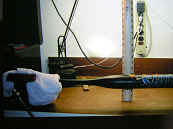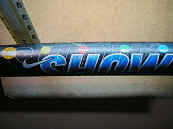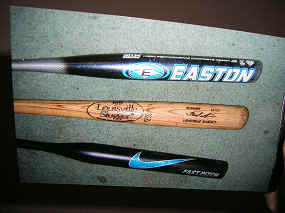


The “Sweet Spot” of a Bat
Carlyn Re & Rachel Bywater
The purpose of this experiment is to find “the sweet spot” of the bat, which we define as the area on the barrel that provides the maximum distance/speed of the ball when hit.
Softball first began in 1887 on Thanksgiving Day in Chicago. After a
Harvard-Yale football game a group of both Yale and Harvard alumni wanted to
play a baseball-like game indoors. Using a metal rod as a bat, they hit the only
ball-like object they could find- a boxing glove, creating the idea of playing
with a "soft ball." This new sport became more and more popular with
those who owned small fields or indoor arenas.
“By 1889 there was a league of teams in the Chicago area, and by 1926 it had
swept across much of the US and was officially named 'softball'” (Bella
Online). Overtime, the sport of softball has become a worldwide aspiration. We
have played softball since kindergarten at different levels of competition, and
we have used several bats with different degrees of technology. We have come to
understand that new technology is always being created, and the performance of
the bats increases every year. There are three main types of bats that are
commonly used: wooden bats, aluminum bats, and composite bats. The barrel (or
fat end of the bat) is the area used to hit the ball. The middle of the barrel
is considered “the sweet spot.”
Although there are many different brands of softball bats, (Louisville slugger, Anderson, Easton, etc.) they are all comprised of the same basic structure. As mentioned in the background information, there are three different types of bats (Wooden, aluminum, and composite). The wooden bat is solid through the core and is mainly used in baseball because of the immense strength the major league baseball players are capable of. The wooden bat prohibits the hitter from generating as great of a hit-ball speed as the composite and aluminum bats can by deadening the ball. The aluminum bat is a single-wall bat that is hollow through the core. According to trustees of Indiana University, “The difference between the aluminum and the wooden bat is that the aluminum bat has more elastic than the wood. “Elastic” meaning it gives more to the ball, kind of like a trampoline effect. When a ball hits an aluminum bat, the aluminum deforms but then immediately springs back, launching the ball outward. The ball maintains most of its energy, versus when it collides with a wooden bat, it loses kinetic energy” (Don and Yael, 2001). Although the aluminum bat is more efficient for distance than the wooden bat, it is not as effective as the composite bat because it is very hard and only having one wall does not put much strength behind the ball at the point of contact. The composite bat is the most recently release technology consisting of a multi-wall structure. Anderson Bat Company (2005) reveals that the most important characteristic of a multi-wall bat is to have flex in the barrel. This ability of the barrel to flex is what the trampoline effect is all about. The reality of today's multi-wall bats is that they have two straight walls and to get the good flex you have to make the walls so thin that they will dent easily. If you make the walls thicker to increase the durability you lose the good flex.
“Rachel and I define the 'sweet spot' of the bat as the portion of the barrel where the maximum distance of the ball can be generated.” Daniel Russell, Ph.D. At Kettering University defines it as the spot on the barrel at which feels best for the hands at the point of contact. Russell reveals, “In the year 2000, important experimental results were published showing that, at least for hollow softball bats tested using the BPF (Bat Performance Factor) test, the center-of-percussion ('The sweet spot') was not the location where maximum ball speed occurs”(Russell, 2005). Although there are other factors in the distance of the hit ball, such as the hitter's strength and the correct form. We will make sure that all the constant variables stay controlled in our experiment to avoid error and invalid results.
We predict that if the ball hits the lower middle of the barrel, then the ball will fire off of the bat with the most speed and travel the most distance than any other portion of the bat, because it is the thickest part of the bat that is closest to the power source (the hitter). The variables we will be measuring are the speed of the ball off of the bat (m/s), and the distance the ball travels after being hit (m). The independent variables are the different types of bats and the different locations the ball hits the barrel.
o
Composite Softball Bato
Wooden Bato
Aluminum Softball Bato
Towelo
Vice (Clamp)o
Tripodo
Digital Camerao
Rulero
Golf Ballo
Stickerso
Computero
Logger Pro Software



1. Five stickers will be placed two inches apart from each other on the barrel of each of the three softball bats. The last sticker should be two inches away from the end of the bat.
2. The stickers are color coded, so there are five different colors, and each represents a certain position on the barrel of the bat.
3. A towel will be wrapped around the handle of the bat to ensure that the vice does not scratch it. We will secure the bat in the vice starting at the end of the handle.
4. The bat will be held horizontally and a leveler will used to check its accuracy. Also, we will tape a three-foot ruler the wall behind the bat, so that the height of the ball can be measured.
5. We will set up the digital camera on the tripod so that the stickers on the bat are visible at the bottom of the screen and there is enough space on the top of the screen to see the highest point of the bouncing ball.
6. To test the best part on the barrel of the bats, a golf ball will be dropped on the five labeled points on the barrel and its recoil will be measured. We will drop the ball about ten times on each point to ensure that there are at least three accurate trials in which the ball bounces straight up. The ball will be dropped at a height of one foot (.3048 m) over the bat.
7. All of the trials will be recorded on the video of the digital camera. Then using the Logger Pro software, the height of recoil on each of the ball trials can be measured.
8. Only the three best trials will be used for the results. The balls need to bounce straight back up off of the bat to be accurate.
9. Then the averages of all the points on the bats will be averaged and organized into data tables and graphs. We will come to a conclusion about our findings and write a lab recounting them.
Composite Bat
|
Trial 1 |
Trial 2 |
Trial 3 |
Average |
|
|
Orange |
0.161 |
0.1513 |
0.1595 |
0.1573 |
|
Yellow |
0.1565 |
0.1771 |
0.1604 |
0.1647 |
|
Red |
0.1757 |
0.2154 |
0.1886 |
0.1932 |
|
Green |
0.2126 |
0.1968 |
0.1591 |
0.1895 |
|
Blue |
0.1207 |
0.1357 |
0.1288 |
0.1284 |
Aluminum Bat
|
Trial 1 |
Trial 2 |
Trial 3 |
Average |
|
|
Orange |
0.1073 |
0.1927 |
0.11 |
0.1367 |
|
Yellow |
0.1778 |
0.1588 |
0.1668 |
0.1678 |
|
Red |
0.1829 |
0.181 |
0.1895 |
0.1845 |
|
Green |
0.1991 |
0.1978 |
0.1411 |
0.1793 |
|
Blue |
0.1196 |
0.1588 |
0.1668 |
0.1678 |
Wooden Bat
|
Trial 1 |
Trial 2 |
Trial 3 |
Average |
|
|
Orange |
0.1465 |
0.1534 |
0.1563 |
0.1521 |
|
Yellow |
0.1798 |
0.1691 |
0.1784 |
0.1758 |
|
Red |
0.1871 |
0.1584 |
0.2037 |
0.1831 |
|
Green |
0.1612 |
0.1738 |
0.1691 |
0.168 |
|
Blue |
0.1345 |
0.1649 |
0.1717 |
0.157 |
Average Percentage of Recoil
|
Composite |
Aluminum |
Wooden |
|
|
Orange |
51.61% |
44.85% |
49.90% |
|
Yellow |
54.04% |
55.05% |
57.68% |
|
Red |
63.39% |
60.53% |
60.07% |
|
Green |
62.17% |
58.83% |
55.12% |
|
Blue |
42.13% |
55.05% |
51.51% |


Our hypothesis was correct; we predicted that the composite bat would have the highest recoil of the ball. Also, we thought that the “sweet spot” of the bat would be at the middle of the barrel, identified by the red sticker. The average recoil at of the “sweet spot” on the composite bat was .1932 meters, followed by the aluminum bat with an average of .1845 meters, and then the wooden bat with an .1831-meter recoil average. This was true for each bat type. The wooden bat resulted with the lowest average recoils for four of the five measured points. We did not estimate however, that the recoil from the wooden bat would be as high as it was. At one point (yellow sticker) the average recoil was greater than that of the aluminum bat. This data suggests that the wooden bat does not achieve as high of recoil as aluminum or composite bats. But it may perform better than most people think, possibly due to its longer barrel. It seems to have more consistent recoil throughout its barrel than the other bats. One error that may have occurred in our investigation is that the ball did not always bounce vertically. We tried to eliminate those trials in which the ball flew to the side, instead of up, in order to get better results. Any errors that occurred were most likely due to human error, such as consistently dropping the ball from the same height, or hitting the same point on the bat each trial. In future investigations, we could get more accurate results possibly by using a softball if a more appropriate experiment set up could be used. Also, more trials could be taken in order to reduce human error.
A & A Sports Outlet- At this site you will find information on the newest technology of composite bats called "PowerArch Technology," and how it works. You may also purchase bats on this site.
www.aasportsoutlet.com/power_Arch.htm <http://www.aasportsoutlet.com/power_Arch.htm>
Bella Online- This website contains the origination and history of softball.
www.bellaonline.com/articles/art11423.asp <http://www.bellaonline.com/articles/art11423.asp>
Aluminum Vs. Wooden Baseball Bats- This site contains an interview with Don and Yael about the difference between aluminum and wooden bats.
www.amos.indiana.edu/library/scripts/baseballbats.html
Physics and Acoustics of Baseball and Softball Bats- This site outlines the specifics of wooden and aluminum bats and their differences.
www.kettering.edu/~drussul/bats.html <http://www.kettering.edu/~drussul/bats.html>
E-Softball Bats- This site outlines the technology of softball bats, and their evolution to today's best bats. There are also some softball bat reviews available.
Metropolis Magazine- This is an article explaining the many designs of bats. It focuses on the bat designers and their search to find the best model. Their goal is to revolutionize the game of softball with their bats.
www.metropolismag.com/html/content_08999/au99bat.htm